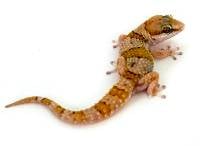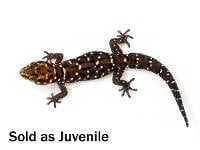Josh's Frogs
Thick-Toed Tiger Gecko (Pachydactylus tigrinus) Care Sheet
By Will Gyurgyik

NAME
The thick-toed tiger gecko (Pachydactylus tigrinus) is so named for the bright bands across its body and for its thick toe pads, which allows these active rock climbers to scale even smooth surfaces. This species is found in dry savannas in South Africa, Zimbabwe, and Mozambique. While they are flighty and don’t enjoy being handled, their penchant for climbing and their active lifestyle makes them fascinating pets to observe.
COLORATION
Thick-toed tiger geckos have a brown base color and are covered with deep or pale yellow stripes, along with pale yellow to white spotting. Their bright pattern bears a striking contrast to their typically dark body color.
HOUSING
A 12x12x12 enclosure can house a pair or trio, with larger enclosures housing more geckos. Males can be housed with a number of females, provided there is enough space and food. This species does well even when housed in large groups. Sand as a substrate can work provided humid hides are present in the enclosure, but a substrate that holds a small amount of moisture, such as DigIt or a sand/coco fiber mixture, is preferred. Desert BioBedding with isopods (dwarf whites or dairy cows or giant canyons all work well), springtails, and succulents can be used to create a beautiful and bioactive semiarid enclosure!
As a nocturnal species, thick-toed tiger geckos spend their days hiding and sleeping under loose stones and inside rock crevices. For those in captivity, many items can be repurposed to provide similar hiding places, such as cork bark, slate, or upside down plant saucers.
These geckos are skilled and active climbers. They should be provided with plenty of climbing material, such as rocks, driftwood, cork bark, manzanita branches, and other items, which they will scale as they search for prey at night. Because these geckos will occasionally dig, it is important that any heavy items, like slate, rocks, or large branches, should be supported by the bottom of the enclosure instead of being placed on top of the substrate.
TEMPERATURE AND HUMIDITY
A temperature range of 75-85 F should be maintained for this species. A daytime hot spot of around 95F should also be provided and can be maintained with a heat pad or heat lamp. Hides should be provided on both the cool and warm side to allow your gecko to thermoregulate without sacrificing security. This nocturnal species requires no special lighting. Temperatures can drop down to 68 F at night.
Though an arid species, midrange humidity levels--between 50%-60%--should be provided, though they will tolerate lower humidity so long as humid hides are provided. Regardless, humid hides are recommended. These geckos should be lightly misted daily or every other day to moisten a portion of the substrate and provide dew on enclosure walls and cage items from which they can drink, but enough ventilation should be provided to allow the enclosure to dry out after a few hours. A shallow water dish can be provided but is not necessary with regular misting. The enclosure should have enough ventilation such that it dries out within a few hours of misting. A shallow water dish can be provided but is not necessary with consistent misting.
Temperature and humidity should be monitored with a digital thermometer/hygrometer. The hot spot can be checked with an infrared thermometer or temperature gun.
 Adult
Adult
SIZE
Thick-toed tiger geckos will reach around 3-4 inches as adults. These geckos, provided proper care, can live around 10-15 years in captivity.
DIET
Thick-toed tiger geckos are insectivores and will thrive on a diet of our feeder insects. A staple of crickets works best. Other small feeder insects (dubia roaches, waxworms, small mealworms) can occasionally be offered. A good rule of thumb for size is to only offer insects whose length does not exceed the space in between the gecko’s eyes. Generally, hatchling thick-toed tiger geckos should be fed insects measuring around ⅛-inch. They can be upgraded to ¼-inch crickets when at the appropriate size. Feeder insects should be gutloaded and dusted with a vitamin/mineral supplement. A food dish is not necessary but will minimize the number of bugs that escape and hide among the enclosure.
SEX
While male thick-toed tiger geckos exhibit a hemipenal bulge, it is inconspicuous and is often difficult to identify in comparison to females. Males are generally smaller than females.
BREEDING
This species will readily breed without cycling or brumation. Females will lay pairs of eggs every 3-4 weeks. It is recommended to occasionally separate the male to allow females to recover, as this species will generally continue to reproduce throughout the year.
Links of Interest:
The Reptile Database - https://reptile-database.reptarium.cz/species?genus=Pachydactylus&species=tigrinus
Animal Diversity Web - https://animaldiversity.org/accounts/Pachydactylus_tigrinus/classification/


